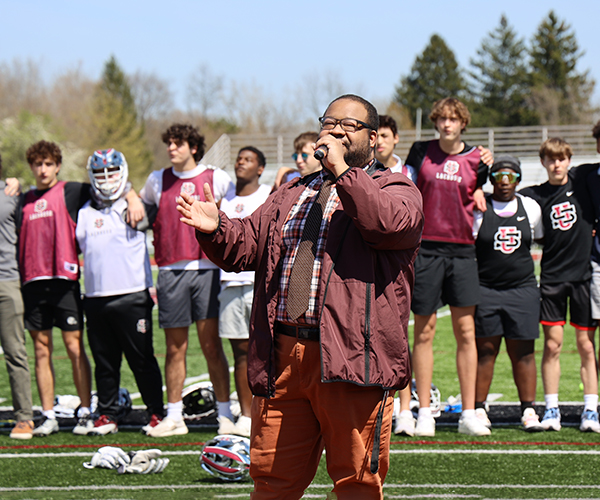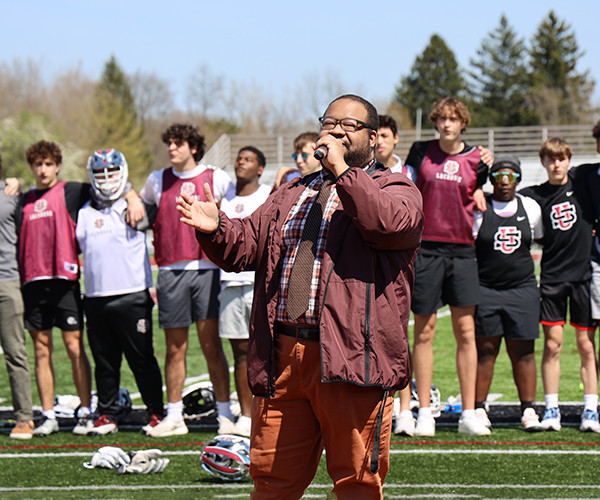You’re working on “the list.”
The college search is underway, and everyone’s got ideas. Your high school junior is building a menu of dream colleges to visit, but you’re wondering how to pay for it all.
For many, the college search process can become a monumental stressor stacked with standardized testing, campus visits, financial aid forms and decisions about how and where to apply. And while the emotional stakes are high, the financial investment, which can range from $10,000 to more than $250,000, may even be greater.
Keeon Gregory, director of college counseling at Lake Ridge Academy and an independent adviser, has worked with more than 1,000 students over the past 18 years. He’s also been through the process twice with his own children, Kendall, 28, and Kaci, 22. Each one followed a very different path in finding colleges that worked for them.
His son, a 400-meter dash track athlete, became a hot commodity for interested universities. “Everyone was calling,” says Gregory. “When your kid has 23 full-ride scholarships, you can forget who your kid is and what’s best for him. It’s easy to lose sight.”
So, they made official visits to several universities, including Ohio State University and the University of Georgia, before finally landing at the University of Michigan. After his freshman year, however, Kendall transferred to Western Kentucky University, where he completed his degree in communications.
For his daughter, Gregory took a more direct route by creating “a list of absolutes.” He and Kaci identified a few must-haves. Gregory wanted a school that met 90 percent of the family’s financial need, was within a workday drive and had at least a 66 percent four-year graduation rate.
Kaci wanted a college with a strong communications or journalism program — ideally close to New York City. She, too, was being recruited for track and field and received partial scholarship offers from two universities. But with established benchmarks as an evaluation tool, the search for college became more specific and less like a free-for-all. She picked Muhlenberg College, a small liberal arts school in Allentown, Pennsylvania, with about 2,200 students.
Last fall, about 20.4 million students attended college in the United States, which is up by nearly 5 million since 2000, according to the National Center for Education Statistics. The average annual price for tuition, fees, room and board in the 2015-16 academic school year was $16,757 at public institutions and $43,065 at private colleges and universities. But how do you tackle the search without getting bogged down by the numbers?
Pairing personal guidelines with expert strategies can help ensure the process is centered on the student and family’s needs while muffling some of the background noise. Before starting your journey, here are 10 overlooked aspects of the college search that parents and students should consider.
Begin with the end in mind
Freshman year of high school is one of the most formative years of a person’s life, says Ted McKown, associate director of admissions at Kent State University. “Everything is changing. Students are in a new school with older peers. They’re maturing. There’s a step up in academics,” he says. “It’s a great time to think about possible career options.”
McKown suggests a “career stream” approach that connects a student’s interests to academic strengths and then to potential careers. That might seem difficult for teens who don’t know what they want to do. But by focusing on what fascinates them, the conversation can become more positive.
McKown, who’s gone through the college search with two kids and has a freshman in high school, says often kids have so many interests they are unsure where to start, so they never seriously consider possible career paths.
“Stir up conversations that lead to realizing what those best-fit institutions could be,” McKown says. “Begin with the end in mind and work backward into an academic program. Then, look at universities that have that program so it can lead to a career.”
Get an objective opinion
As a parent, you believe in your child’s abilities. But now that the college admissions office is in charge of judging your child’s acceptance, that shift can be daunting.
Parents worry their child won’t get into their top-tier schools, says Gregory. “That is the No. 1 stressor for parents because, now, someone else is making a decision about their child.”
Temper this anxiety with reality. Be honest about whether you’re truly an objective party by developing a personal relationship with the school counselor or adviser.
“Come at it from the perspective of, What does my child need to work on?” Gregory suggests. “Every child has something they can do better.”
When having candid conversations with a counselor, parents and students shouldn’t be afraid to ask questions or seek clarification of college-admissions jargon.
“It’s like when you go in for medical testing and a doctor throws terms at you that you don’t understand,” says Tracy Stockard, director of college counseling at Gilmour Academy. “Let the admission officer know if they’re talking about something you’ve never come across.”
Take the test again
College admissions are linked to academic success in high school and part of that equation includes applicants’ SAT and ACT test scores.
So, what if your kiddo is not a strong test-taker but earns great report cards?
Christopher Buttenschon, senior assistant director of admissions at Kent State University, assures it’s not all about the test. But since those scores are a standardized factor that cuts across schools, backgrounds and grade point averages, it’s worth getting plenty of test preparation to increase the likelihood of your best possible score.
In fact, those who take the SAT a second time often see slightly higher scores, according to the College Board. The first test can also be used to discover where a student struggles, whether it’s a weak subject or the need for more formal accommodations.
“You want to be at your best when the test counts,” says Gregory. “So if you can pick up 100 points a year [starting as a freshman], by the time you’re in 11th grade, that score will look different.”
On the other hand, just because you are permitted to take the ACT 12 times doesn’t mean you should. “For every competitive school, nothing supersedes the transcript,” he says.
Focus on academics
For many families, it’s easy to get lost in the search process as students focus on criteria such as school size, setting and reputation. That’s why an experienced college counselor is important to a successful search.
“Think about advising in a more substantive way,” says Renee Bischoff, director of college counseling at Hawken School. “Find out who will be your mentor, who will guide you.”
To help kick-start the process, Hawken provides questionnaires to learn students priorities as they embark on the college search.
Bischoff strives to place her students in colleges with an engaging environment inside and outside of the classroom while maximizing a school’s value propositions.
For Gilmour’s Stockard, that means focusing on academics. “That is what you are going to college for,” she says.
So don’t just write off a school that fits your academic criteria, because it falls outside one of those broader parameters. Big schools have innovative ways to act small. Small schools can marshal resources to provide big opportunities.
“I always tell parents to think about signature programs and research opportunities that exist at a big school to make that school more personal to you,” Bischoff says.
Ohio State’s Honors & Scholars program, for example, allows undergrads the opportunity to take advanced classes, live in specialized residential learning communities and attend feature events. These programs can offer greater mentoring opportunities as well.
“The financial burden of college forces students to think of college as career preparation and advising is central to that,” Bischoff says. “Find out how advisers engage students in experiential learning and interactive activities.”
Have the money talk
All colleges are required to include the Net Price Calculator on their website, making it a valuable tool for families to make a fair cost comparison among potential colleges.
The calculator asks a series of questions about your financial status to estimate your expected family contribution. Then, it shows the total cost of attendance, total amount of aid awarded to all students through grants and scholarships, and the cost of attendance after the financial aid is awarded.
The Net Price Calculator can be an important first step in initiating financial conversations with your college-bound children.
The earlier families talk money, the better, says Missy Rose, director of college guidance for Laurel School. “Don’t wait until your child is accepted to her dream college and it’s April of her senior year and you say, ‘We can’t afford this,’ ” Rose suggests.
“Have the conversation with your child upfront,” she says. “There needs to be schools on the list that are highly likely for affordability — and that can be overlooked.”
To avoid confusion and misguidance, apply early for the Free Application for Federal Student Aid (FAFSA). Typically, enrollment opens Oct. 1 for the following fall semester and closes June 1. But be prepared. It’s long and complicated, so do some prep work and organizing throughout the year.
“The financial aid picture seems to change every year,” says Buttenschon. “For priority consideration, high school seniors really need to apply by Dec. 1.”
Ask the financial question: Can we get help?
Talk to financial aid offices early on and develop a relationship with someone in the department who can walk you through the planning process. Then, have the confidence to ask about your eligibility for institutional scholarships, says Angela Johnson, vice president of access and completion for Cuyahoga Community College.
It can be tough for families to understand direct and indirect college costs. Plus, there’s always sticker shock, she says. Financial aid is dependent on income based on taxes from two years prior, so a lot can change at home.
“Maybe there was a job loss or another reason why a family’s income changes,” Johnson says. “Recognize that as an opportunity to ask for an adjustment in your eligibility for financial aid.”
Be your own tour guide
The college tour guide will be a positive advocate for the school you’re visiting. So don’t rely on insight from the guide alone.
Talk to other students, connect with the public safety office and drive off campus to get a feel for the neighborhoods. “Does it feel like a place where your child can live without a car?” asks Rose. “What options are available to them on and off campus?”
Ask about the most important issues on campus and pick up a copy of the college newspaper to find out what students are talking about, suggests Stockard. Similarly signing up for the school’s mailing list provides important insights into the community.
“A lot of schools will track ‘demonstrated interest’ — what you’re doing to show your interest in them,” Stockard says. “Because typically students who show demonstrated interest have a better percentage chance of graduating down the road.”
And it’s OK if you don’t immediately fall in love with the campus, even if it feels like an ideal fit on paper.
“Not every student walks onto a college campus and says, ‘This is it!’ ” says Stockard. “A lot of kids have a false perception that they’ll know, This is where I need to be, and there’s a wave of relief when I tell them that for most kids that doesn’t happen.”
Get organized
Nominate yourself secretary for the search process by designating a couple times each week to talk about college on a Saturday morning at the kitchen table or Sunday before dinner. But avoid inundating your child with college talk in between those times.
By setting a college discussion schedule at home, you can avoid a common issue families face when they make junior and senior year all about college.
“Kids come to me and they are just so tired of hearing and talking about college,” Stockard says. “They feel it’s all any grown-up wants to talk to them about, so be mindful of this.”
Don’t sweat small mistakes
Don’t obsess over minor missteps in high school such as a B-plus in biochemistry or one bad geometry test.
“Give students some independence during their high school experience,” Bischoff suggests. “A kid with straight A’s and perfect test scores might not have the depth to think about their intellectual curiosities because they have been too busy on the gerbil wheel of perfection.”
Meanwhile, a student with a 3.5 grade point average might be more in tune with what they’re passionate about, so the lesson is to let go a little.
“Everyone says they want their kid to be happy,” says Bischoff. “But that means you have to let your child grow a little bit in his or her own space.”
Remember, your kid is watching
Laurel School’s Center for Research on Girls conducted a study that showed when parents’ expectations are significantly higher than girls’ expectations for themselves, “self-esteem plummets,” Rose points out.
“They are watching for signs of approval or disapproval, and that could mean a raised eyebrow, crossed arms, a tone of voice,” Rose says. “Most kids want to please their parents, and if they get a sense that certain schools are not OK, it’s tough for them to deal with.”
__________
Search List
If you’re having trouble whittling down the list of more than 4,700 higher education institutions in the United States, our experts offer some pointers so you can take a deep breath.
Categorize your school listings. Divvy up schools into four categories: safe schools which are sure bets, match schools that pair up with your financial budget, reach schools that are highly selective and those dream schools you never thought you’d get into. Then, apply to your top schools in each category. “That way, you’ll ensure that you have some nice options when it all plays out,” says Tracy Stockard, director of college counseling at Gilmour Academy. “I always encourage kids to shoot for the stars.”
Set priorities. Brainstorm what makes a college “the best,” and factor in location, size, diversity of campus life and abundance of academic programs. Make a list of your priorities, then ask your student to do the same. Use these parameters to focus in your search, says Keeon Gregory, director of college counseling at Lake Ridge Academy.
Visit sample schools. You can conduct a totally local search of colleges to get a taste of whether you prefer a small or large school, an urban campus or small town. “You don’t have to visit colleges all over the country to get a sense of what type of college will work for you,” says Missy Rose, director of college guidance at Laurel School. Once you narrow priorities, you can rule out schools and save traveling all over to find out if you’re a big-campus student or not.
Stop at 10. Laurel encourages its girls to file applications at up to 10 colleges and universities — and stop there. “It’s a lot of work to apply to colleges. It takes a lot of time,” says Rose. “They need to balance the application process with their courses, their extracurricular activities and for some families, the cost.”




